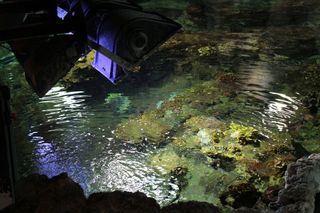Fishes, Tanks, Lights!
Aquariums and their lights
When building an aquarium tank, you must also consider what type of aquarium lighting you are going to choose. For the most part, the tanks light is used for you, to see better the colors of your fish and tank itself. The aquarium should not be in direct sunlight since this will cause the water to overheat which then causes algae to grow rapidly. If you plan to have plants in your tank you need a significant amount of light for the plants to produce photosynthesis. Planted tanks require between 2 and 5 watts per gallon while fish-only tanks should at least have 1-2 watts per gallon of light. Let’s go more into depth with fish-only tanks
For a fish only tank you need to consider and research what type of fish you are getting: fish that like bright light or fish who like dark places. The lighting you need for your tank will depend on what type of fish you keep. Most fresh water fish come from lakes and streams so they are accustomed to bright warm rays. Light spectrum is given a “K rating” which stands for Kelvin. The more yellow/warm tones have low Kelvin ratings while the white/blue lights have a high Kelvin rating. The ideal lighting system would consist of a color temperature between 5,500 and 6,500k.
For planted tanks you also need to consider and do research on what plants you are going to purchase in order to determine how much light is sustainable. Tropical plants need a high level of light to properly photosynthesize such as the banana, amazon, java, and water fern plants. The light should be on for at least 10-12 hours a day but if let on for too long algae can grow and turn the water green. The ideal lighting system would consist of a color temperature between 6,500 to 8,000K.
Types of Lighting Bulbs
Actinic is mostly used for saltwater aquariums that contain coral since it promotes their growth and enhances their beauty. This lighting also limits the growth of algae since it cannot properly photosynthesize from blue and violet light and it also pierces deep water where algae normally grows.
Fluorescent light bulbs were once the most common in aquariums since they produce relatively low heat and are cheap. These bulbs are known to die out faster but can be commonly found in any fish store. Fluorescent bulbs range between 15 to 54 watts depending on which version you choose: standard, compact or T-5 High Output.
LED lights are not actually light bulbs but light emitting diodes. LEDs have a unique shimmer affect on the water and will not heat up. LED lights last longer and use up less energy than traditional aquarium lighting. They can produce numerous colors and offer soft, warm, or cool light for the aquarium.
Depending on how deep and the overall volume of your tank will determine the actual bulbs you may need for your tank. For aquariums that are between 18-24 inches deep, you will need a lighting system that is slightly stronger especially if you plan to keep live plants or corals. A high-intensity lighting system like T-5 HO is recommended. You can also use compact fluorescent lights in fish-only tanks. If the tank is more than 24 inches deep or you have many plants or coral you will need a high intensity lighting system with many bulbs.
Also consider buying or adding a light timer for your tank. You should not suddenly turn off the light because it might shock the fish, especially if the light emits heat. Remember, lighting influences the fishes behavior and physiology and should mimic the sun as if they were in their natural habitat.




